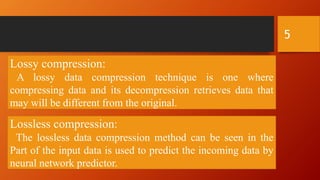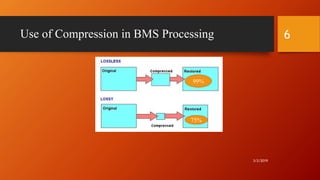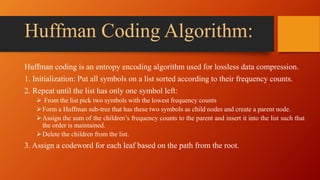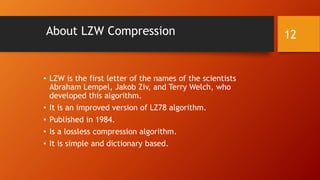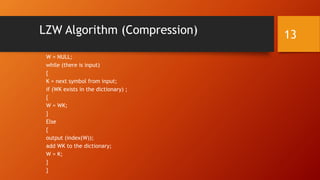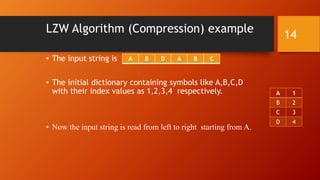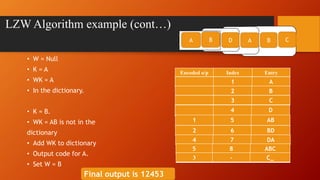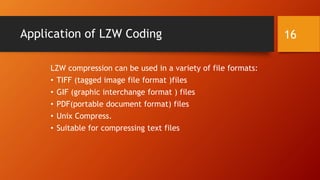Data compression & Classification
- 1. Welcome to my presentation On Data Compression
- 2. 3/2/2019 2 Presented To: Dr. Md. Maniruzzaman Professor ECE Discipline Khulna University, Khulna-9208 Email: m_m_zaman@hotmail.com Presented by: Md. Golam Rousul Student ID: MSc-190903 ECE Discipline Khulna University, Khulna-9208 Email: rousul.ku@gmail.com
- 3. Compression: Compression is a way to reduce the number of bits in a frame but retaining its meaning. Data Compression: Data compression is the process of encoding data so that it takes less storage space or less transmission time than it would if it were not compressed. Data Compression 3/2/2019 3
- 4. Types of Data Compression 3/2/2019 4 Data Compression Lossless Method (text or program ) Lossy Method (Image, video, audio )
- 5. 3/2/2019 5 Lossy compression: A lossy data compression technique is one where compressing data and its decompression retrieves data that may will be different from the original. Lossless compression: The lossless data compression method can be seen in the Part of the input data is used to predict the incoming data by neural network predictor.
- 6. 3/2/2019 6 99% 75% Use of Compression in BMS Processing
- 7. 3/2/2019 7 Lossless Compression Entropy Based Dictionary Based RLE Arithmetic Huffman Simple Byte LZW Types of Lossless Compression
- 8. Huffman Coding Algorithm: Huffman coding is an entropy encoding algorithm used for lossless data compression. 1. Initialization: Put all symbols on a list sorted according to their frequency counts. 2. Repeat until the list has only one symbol left: ’āś From the list pick two symbols with the lowest frequency counts ’āśForm a Huffman sub-tree that has these two symbols as child nodes and create a parent node. ’āśAssign the sum of the childrenŌĆÖs frequency counts to the parent and insert it into the list such that the order is maintained. ’āśDelete the children from the list. 3. Assign a codeword for each leaf based on the path from the root.
- 9. Example 3/2/2019 9 Symbol Count /Frequency A 15 B 7 C 6 D 6 E 5
- 10. Constructing A Tree of Nodes B(7)C(6)D(6)E(5) (13)(11) (24)A(15) (39) 0 1 10 10 0 1 A=0 E=100 D=101 C=110 B=111
- 11. Huffman Coding Result Symbol Count Bits A 15 0 B 7 100 C 6 101 D 6 110 E 5 111
- 12. About LZW Compression ŌĆó LZW is the first letter of the names of the scientists Abraham Lempel, Jakob Ziv, and Terry Welch, who developed this algorithm. ŌĆó It is an improved version of LZ78 algorithm. ŌĆó Published in 1984. ŌĆó Is a lossless compression algorithm. ŌĆó It is simple and dictionary based. 12
- 13. LZW Algorithm (Compression) W = NULL; while (there is input) { K = next symbol from input; if (WK exists in the dictionary) ; { W = WK; } Else { output (index(W)); add WK to the dictionary; W = K; } } 13
- 14. LZW Algorithm (Compression) example ŌĆó The input string is ŌĆó The initial dictionary containing symbols like A,B,C,D with their index values as 1,2,3,4 respectively. ŌĆó Now the input string is read from left to right starting from A. 14 A B D A B C A 1 B 2 C 3 D 4
- 15. LZW Algorithm example (contŌĆ”) ŌĆó W = Null ŌĆó K = A ŌĆó WK = A ŌĆó In the dictionary. ŌĆó K = B. ŌĆó WK = AB is not in the dictionary ŌĆó Add WK to dictionary ŌĆó Output code for A. ŌĆó Set W = B 15 Encoded o/p Index Entry 1 A 2 B 3 C 4 D 1 5 AB 2 6 BD 4 7 DA 5 8 ABC Final output is 12453 A B D A B C 3 - C_
- 16. Application of LZW Coding LZW compression can be used in a variety of file formats: ŌĆó TIFF (tagged image file format )files ŌĆó GIF (graphic interchange format ) files ŌĆó PDF(portable document format) files ŌĆó Unix Compress. ŌĆó Suitable for compressing text files 16
- 17. The CR is given by: CR = ØÉĄØæ¢ØæĪ ØæģØæÄØæĪØæÆ Øæ£Øæō ØæéØæ¤Øæ¢ØæöØæ¢ØæøØæÄØæÖ ØæĀØæ¢ØæöØæøØæÄØæÖ ØÉĄØæ¢ØæĪ ØæģØæÄØæĪØæÆ Øæ£Øæō ØÉČØæ£ØæÜØæØØæ¤ØæÆØæĀØæĀØæÆØææ ØæåØæ¢ØæöØæøØæÄØæÖ It includes different parameters of compression. When the compression ratio increases the cost of transmission of the data to the monitoring center also reduces. Compression Ratio (CR):
- 18. 3/2/2019 18





